- Trans Pecos
- High Plains/Panhandle
- Cross Timbers
- Hill Country
- Post Oak Savannah
- Pineywoods
- Oak Prairie
- South Texas Plains
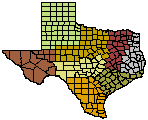
Wildlife Division District Map
Post Oak Savannah and Blackland Prairie Wildlife Management
Historical Perspective
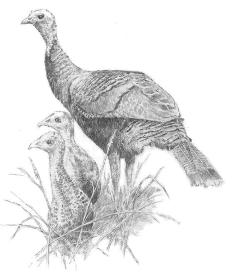
Turkey Hen and poults.
Wildlife Division District 5 encompasses a 31 county area extending south from the Red River to Grimes, Brazos, Burleson and Milam Counties. The district is bordered by the Cross Timbers and Prairies Ecoregion to the west, and the Pineywoods Ecoregion to the east. The western 13 counties, or portions thereof (see Texas Ecoregion Map), fall within the Blackland Prairie Ecoregion. The remaining 18 counties fall within the Post Oak Savannah Ecoregion. Average annual rainfall ranges from approximately 35 inches in the western counties to 45 inches in the eastern counties. The terrain is nearly level to gently rolling with elevations ranging from 300 ft. above mean sea level in the south to 800 ft. in the north.
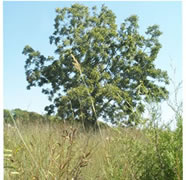
Blackland Praire indian grass.
There are 13 counties in the western portion of the district that are associated with the Blackland Prairie Ecoregion. Pre-settlement conditions of this region were that of a true prairie grassland community dominated by a diverse assortment perennial and annual grasses and forbs (weeds). Many early settlers who first encountered the Blackland prairie described it as a vast endless sea of grasses and wildflowers with sparsely scattered trees or mottes of oaks on uplands. Forested, or wooded areas were restricted to bottomlands along major rivers and streams, ravines, protected areas, or on certain soil types.
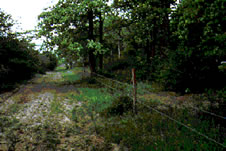
Post Oak Woodland vegetation.
The remaining 18 counties within the district are part of the Post Oak Savannah Ecoregion. As the name implies, the original plant community associated with this region was a savannah dominated by native bunch grasses and forbs with scattered clumps of trees, primarily post oaks. Forested areas were generally restricted to bottomlands along major rivers and creeks, or in areas protected from fire. Soils within the area are unique. Sands and sandy loams are predominantly found on upland sites, while clay or clay loams are typically associated with bottomlands. A dense clay pan, that is almost impervious to water, underlies all soil types within the region at depths of only a few feet.
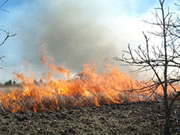
Prescribed Fire burning grass.
The Blackland prairie and Post Oak Savannah landscapes were formed and maintained by two major forces: frequent fire and grazing of bison. Recurrent fires ignited either by lightning or humans (American Indian) were the major force that molded the prairie and savannah landscapes. These fires were typically very large in scale and would traverse the countryside until they reached landforms or conditions that would contain them (rivers, creek bottoms, soil change, topographical change, climatic change, or fuel change). Fire maintained these plant communities by suppressing invading woody species and stimulating growth of prairie grasses and forbs. Large herds of bison, sometimes as large as 1,000 animals, ranged the prairies and savannahs, where they would consume large quantities of grasses, trample organic matter, and then distribute seed into the disturbed soil. The grazing pressure was not continuous, however, and the large herds would move on allowing the range time to recover.
One of the earliest uses of the Blackland Prairies and Post Oak Savannah by early settlers was grazing livestock, primarily cattle and horses. Farming was also common but did not become a major use until the 1870’s. During this time, with the advancement of the railroads and improved market conditions for agriculture, the prairies were plowed under and cotton replaced ranching as the principle land use. The rich soils of the Blackland Prairie were ideal for growing cotton and in a relatively short time, a majority of the desirable land was cultivated, leaving only small remnants of the original prairie intact. In the Post Oak Savannah, the land was cleared and tilled by farmers and ranchers and the use of fire was all but eliminated. The result has been a high density of mostly smaller trees with a thick understory of yaupon. Farming is still a major land use in the Blackland Prairies region today, but a large portion of the previously farmed land has been converted to pastureland (mostly monocultures of Old World bluestems, bermudagrass, or bahaiagrass) for grazing livestock. Today, the Post Oak Savannah, much like the Blackland Prairie, has been converted into vast acreages of improved pastures consisting of Bermudagrass and/or Bahaia grass.
The changes to the land that have occurred over the last 100 or so years, have dramatically altered the flora and fauna of these regions. The once diverse wildlife communities that occurred on the prairies and savannahs have been reduced dramatically, and continue to decline. With continued growth and urbanization within these regions, wildlife populations are at risk now more than ever. However, private landowners provide the key to securing the future of wildlife in these regions. With a sound, holistic approach to land management, the diversity of flora and fauna can be maintained or even enhanced over the coming decades. Aldo Leopold stated it best in his 1933 textbook Game Management. “…game can be restored by the creative use of the same tools which have heretofore destroyed it –ax, plow, cow, fire and gun.” Therefore, our task as land managers is to understand the basic principals that make our system function as a whole and to apply the necessary tools in the manner in which they are needed.
References
- George M. Diggs, Jr. et al, 1999. Illustrated Flora of North Central Texas. Botanical Research Institute of Texas, Ft. Worth, TX, USA.
- Packard, Stephen, Mutel, Cornelia F., 1997. The Tallgrass Restoration Handbook: For Prairies, Savannahs, and Woodlands. Island Press, Washington, D.C./ Covelo, California, USA.
- Rideout, David W., 1994. The Post Oak Savannah Deer Herd Past Present and Future. PWD RP W&100-237B.
- Schmidly, D. J. 2002, Texas Natural History: A Century of Change. Texas Tech University Press, Lubbock, Texas. (pp 371-374).